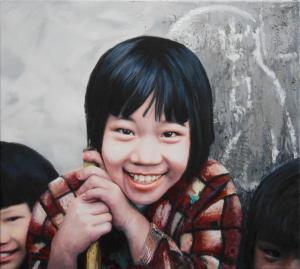Sale on canvas prints! Use code ABCXYZ at checkout for a special discount!

John Sanden claims that “a broad smile is almost always wrong in a portrait.” He gives three reasons. First, practicality. Painting from life rather than a photograph is the preferred method of professional portraiture, and it is too cumbersome for the model or subject to hold a smile for hours at a time. Second, “high art.” The standards for traditional portraiture are more “dignified” than photography and can only be represented by “gravitas,” a solemn or serious expression. Third, monetary value. If any of the great paintings by Leonardo, Rembrandt, or Sargent “featured a broad, toothy smile, the gavel price at Sotheby’s… would go down by many millions of dollars.”
Of course, the customer has the final word on how the artist is to represent the subject of a portrait. Centuries ago, it was mandatory that the artist portray the person as someone to be respected or feared, like a knight, king, or queen. Today, the artist must represent the person as likeable, a team player, or someone you would vote for. Sanden admonishes portrait artists who disregard the importance of tradition in their profession; they should not “void the timeless standards of the centuries” by bowing to the standards of photography. For Sanden, candid photographs have their place, but only on a table at the foot of the portrait painting on the wall.
First, painting solely from life is not necessary, and Sanden even recommends the use of photography in portrait painting. At a Portrait Institute convention many years ago, he demonstrated a homemade device that projected a slide of a model onto a translucent screen. The live portrait, he said, needed to sit only for getting skin tones and values correct, not the expression.
Second, “high art” is phony. The most likely reason why Sargent’s female subjects never smiled was because they were British and had bad teeth. There may have been a few with beautiful teeth, but, if the queen didn’t, the precedent was set. In America, the standard was set when George Washington didn’t smile for his portrait for fear of showing his wooden dentures. So much for historical tradition.
Third, monetary value is not necessarily the most important value. Sanden says the Mona Lisa’s smile is “enigmatic…and very hard to read.” Mysterious might be a better word, but current analysis of Lisa Gioconda’s skeletal remains might indicate otherwise, perhaps an ailment or just plain horsy teeth, a genetic characteristic which her descendants to this day retain.
A personal bond exits between artist and portrait. This bond is broken when the portrait is sold and displayed in a foreign setting. Strangers look at the portrait and react to it, some favorably and others unfavorably. If the portrait smiles, it does so for everyone. It is unchangeable, constant, and unable to react to the face of the other, a face which might even be violent. A smile is a risk that few artists are willing to take.
A smile is an expression of emotion, which is not only manifest in the mouth but all areas of the face. It is the face of joy and friendliness that is instantly understood. Research done by famed psychologist Paul Ekman defined a taxonomy of facial expressions that applies universally to all cultures and peoples. A smiling face is an indicator of a certain emotion. However, discrete smiles, like that shown on Leonardo’s famous portrait, are not readily understood. The viewer is at a loss as to what might have provoked the smile or what emotion the person might have.
We all have seen emoticons that convey emotion in electronic messages or the refrigerator magnet that lets you put a frame around the caricature you feel today. Thirty faces that display thirty human emotions. How do you feel today? Frustrated? Happy? Ashamed? Ecstatic? Bored? Impossible to say, since emotions are so transient. Thus, the portrait artist settles for a stoic face, one that is patient and enduring. However, to many viewers, such a face might easily be taken for a mug shot, which is also emotionless.
So, is a broad smile “always wrong in a portrait?” Had I painted Taipei Twins with a stoic face, she wouldn’t have conveyed the innocence and trust that I wanted to express. It’s a face that shows unqualified trust in the artist. It’s a smile that expresses the joy I felt in painting a beautiful face.
Despite what traditionalists might think, a broad smile in a portrait can be beautiful and, therefore, not always wrong.